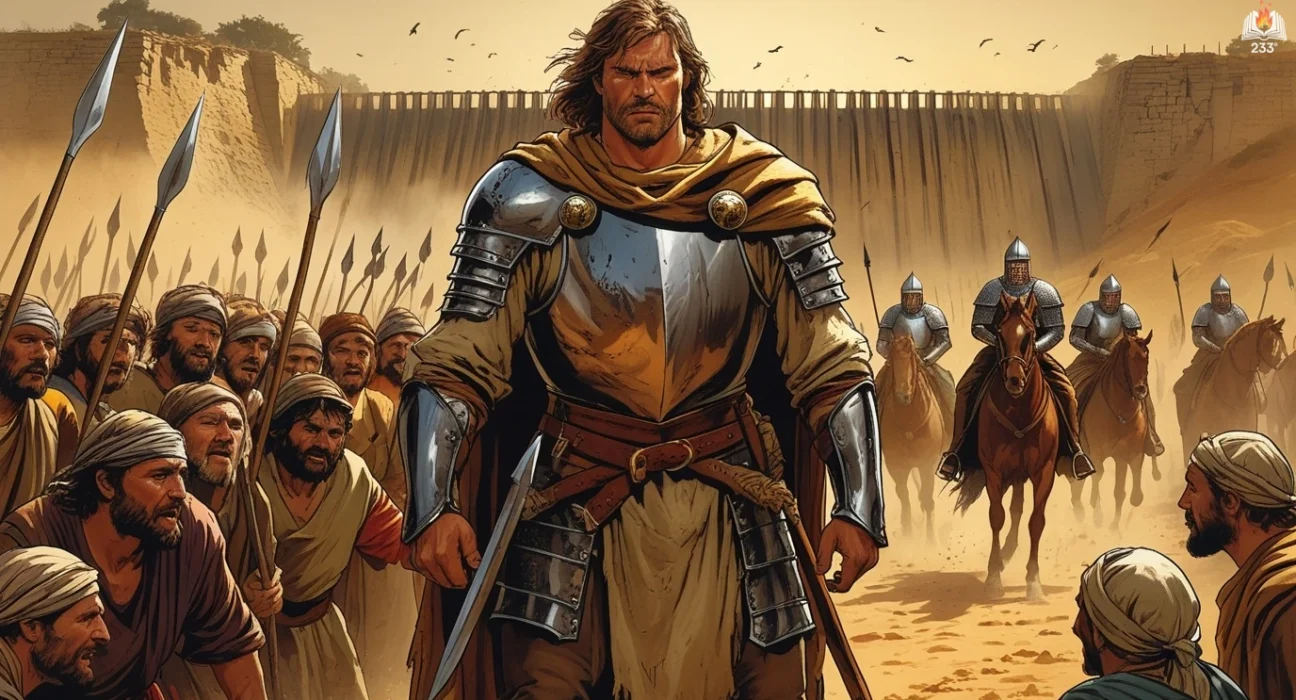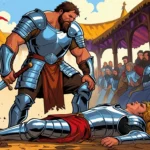“The Sworn Sword” by George R.R. Martin, published in 2003, is the second novella in the Tales of Dunk and Egg series, later compiled in A Knight of the Seven Kingdoms. Set nearly a century before the events of A Song of Ice and Fire, it follows Ser Duncan the Tall, a hedge knight, and his squire Egg, the future Aegon V Targaryen. This tale of feudal conflict and loyalty unfolds in the drought-stricken lands of Westeros, where disputes over water and honor reveal the complexities of medieval power struggles.
Plot Summary
In the sweltering heat of a second year of drought, the sun bore down on the lands of the Reach, cracking the earth and draining life from its rivers. Ser Duncan the Tall, known simply as Dunk, rode beneath the blazing sky with his young squire, Egg. They served Ser Eustace Osgrey, the lord of a meager tower called Standfast, whose lands had long since diminished along with his fortunes. As they returned from procuring wine for their aging lord, they discovered that the nearby stream, the Chequy Water, had run dry. This stream was the lifeblood of Eustace’s dwindling lands, vital to the crops and the peasants who worked them.
The stream, it seemed, had not dried of natural causes. Lady Rohanne Webber, the Lady of Coldmoat—known widely as the Red Widow—had dammed it on her side of the border, diverting the water to her lands. Eustace, already bitter from past losses and betrayals, saw this act as an affront to his honor. Dunk, a sworn sword in Eustace’s service, was tasked with investigating the situation, and alongside him went Ser Bennis of the Brown Shield, a crude and mean-spirited knight whose presence only fueled tensions.
Riding along the dried streambed, they soon found the dam—a solid construction of wood and stone, guarded by smallfolk laborers working under the orders of Coldmoat. Bennis, ever quick to provoke, escalated the situation by slashing the face of an elderly digger. Dunk tried to de-escalate the conflict, but the damage was done. The diggers promised to carry word back to Lady Rohanne, and Dunk knew that violence would not end with a single wound.
Upon returning to Standfast, Dunk delivered the grim news to Ser Eustace. The old knight, consumed by his pride and a desire to reclaim the glories of his family’s past, refused to back down. Once, the Osgreys had been a proud house with vast holdings, but those days were long gone. Eustace commanded Dunk to rally the smallfolk, a pitiful collection of peasants, to prepare for a confrontation. Dunk was uneasy. The men were poorly armed and untrained, and the thought of pitting them against the knights and men-at-arms of Coldmoat seemed folly. Still, a sworn sword’s duty was to obey.
As the days passed, Dunk drilled the villagers with wooden spears and makeshift shields, teaching them the rudiments of fighting. Among them were men barely of age, a simpleton called Big Rob, and others unfit for battle. Eustace, however, stirred their spirits with tales of their forebears’ glory, invoking the chequy lion of his banner and the honor of their shared name. Meanwhile, Dunk wrestled with his own sense of justice. The drought had left everyone desperate, and while Eustace saw Rohanne’s dam as theft, Dunk understood the Red Widow’s need to save her own lands and people.
As tensions mounted, Dunk was sent to Coldmoat to parley with Lady Rohanne. Her castle loomed large and well-fortified, a testament to her wealth and power. The Red Widow, younger than Dunk had imagined, greeted him with a sharp tongue and a wary gaze. Her reputation as a schemer and a poisoner preceded her, but Dunk found her to be more complex than the tales suggested. She was pragmatic and intelligent, defending her actions as necessary for the survival of her people. Though she offered to resolve the matter with coin, Eustace’s pride made such terms unthinkable. Rohanne warned Dunk that Ser Eustace’s refusal to relent would lead to bloodshed, and she made clear that she would not hesitate to protect her lands.
The fragile peace unraveled when Rohanne’s knights appeared near the dam to confront Dunk and Bennis. Outnumbered and outmatched, Dunk chose words over steel, managing to forestall outright violence. Yet it was clear to all involved that the conflict was spiraling toward war. Upon his return to Standfast, Dunk pleaded with Eustace to accept a compromise, but the old man’s stubbornness ran deep. The dam had become a symbol of defiance, and he was determined to fight for what he saw as his birthright.
The battle came swiftly, if it could even be called such. Eustace’s ragtag levy marched toward the dam, where Rohanne’s well-trained knights awaited them. Dunk knew the fight was hopeless, but he stood with the peasants, determined to shield them from the worst of the coming violence. Before blood was spilled, however, Lady Rohanne rode out to confront Eustace herself. Her words were barbed, and their exchange revealed old wounds. The enmity between them was not merely over land or water; it was personal. Rohanne accused Eustace of abandoning the cause of Daemon Blackfyre, the pretender who had died in rebellion years earlier, while Eustace branded her a traitor for her allegiance to House Targaryen.
In the heat of the confrontation, Dunk intervened, imploring them to find another way. His words carried weight, and the two adversaries reluctantly agreed to parley. Rohanne proposed a marriage alliance, a solution that would unite their lands and bring peace. Eustace, though wary, saw in the offer a chance to restore the Osgrey name. Dunk, skeptical of both their motives, nevertheless recognized the wisdom in ending the feud without further bloodshed.
The dam was dismantled, and the Chequy Water flowed once more. Ser Eustace returned to Standfast, his pride bruised but his lands intact. Dunk, ever the sworn sword, pondered the fragile nature of honor in a world where power often eclipsed justice. As for Lady Rohanne, her sharpness remained, but her alliance with Eustace hinted at the possibility of a more tempered future.
Under the blazing sun, life in the Reach carried on. The drought still gripped the land, and tensions lingered like an unhealed wound. Yet, for a time, the Chequy Water ran free, nourishing fields and hopes alike. Dunk and Egg prepared for the next chapter of their wandering journey, bound together by loyalty and the promise of new adventures under a sky that offered no relief but plenty of stories to tell.
Main Characters
Ser Duncan the Tall (Dunk): A humble and towering hedge knight whose moral compass and simple honor guide his decisions. Dunk strives to balance loyalty to his lord, Ser Eustace, with his growing awareness of the injustices around him.
Egg (Aegon V Targaryen): Dunk’s precocious and sharp-witted squire, who conceals his royal lineage. Egg’s observations and curiosity add depth to the story, while his fiery temper occasionally causes friction.
Ser Eustace Osgrey: An elderly, once-proud lord whose dwindling lands and legacy have left him bitter and desperate. His stubborn adherence to past glories drives much of the novella’s conflict.
Lady Rohanne Webber (The Red Widow): A formidable and shrewd noblewoman, reputed for her ruthlessness. Her pragmatism and political acumen contrast with Eustace’s nostalgia, and her alliance with Dunk is pivotal.
Ser Bennis of the Brown Shield: A coarse and morally bankrupt knight in Eustace’s service. His cruelty and recklessness exacerbate tensions between Standfast and Coldmoat.
Theme
Honor and Loyalty: Dunk’s internal struggle reflects the precarious balance between personal morals and feudal duty. His interactions with Eustace and Rohanne explore the cost of loyalty in a world rife with shades of gray.
The Passage of Time: Eustace’s fixation on his family’s bygone glory and Rohanne’s pragmatic outlook highlight the inevitability of change and the tension between tradition and adaptation.
Feudal Injustice and Power Dynamics: The novella critiques the rigid social hierarchies of Westeros, where lords and knights exploit the peasantry. The drought’s toll on commoners underscores the harsh realities of medieval feudalism.
Conflict and Resolution: The dispute over water rights serves as a microcosm for larger political conflicts in Westeros, showcasing the human costs of power struggles.
Writing Style and Tone
George R.R. Martin’s writing in The Sworn Sword is evocative and richly detailed, weaving the mundane and the extraordinary seamlessly. He masterfully uses vivid descriptions to paint a harsh and parched Westerosi landscape, where every drop of water symbolizes life and power.
The tone is reflective and bittersweet, capturing the nuanced relationships between characters. Martin employs sharp dialogue to explore moral dilemmas and the harsh realities of knighthood. The blend of humor, grit, and poignant introspection ensures an engaging and immersive narrative that complements the broader lore of A Song of Ice and Fire.
We hope this summary has sparked your interest and would appreciate you following Celsius 233 on social media:
There’s a treasure trove of other fascinating book summaries waiting for you. Check out our collection of stories that inspire, thrill, and provoke thought, just like this one by checking out the Book Shelf or the Library
Remember, while our summaries capture the essence, they can never replace the full experience of reading the book. If this summary intrigued you, consider diving into the complete story – buy the book and immerse yourself in the author’s original work.
If you want to request a book summary, click here.
When Saurabh is not working/watching football/reading books/traveling, you can reach him via Twitter/X, LinkedIn, or Threads
Restart reading!








